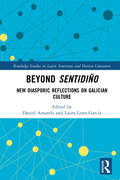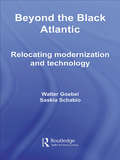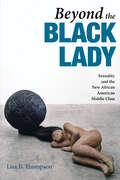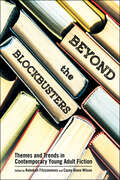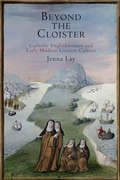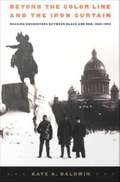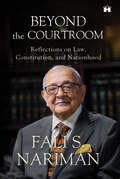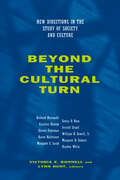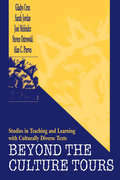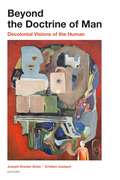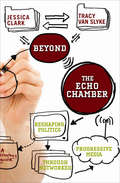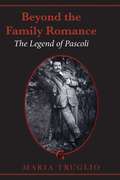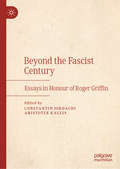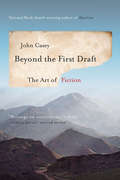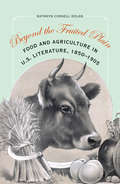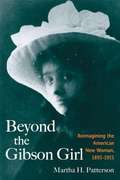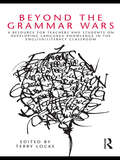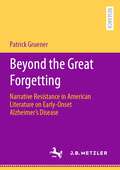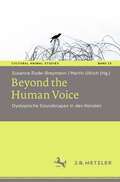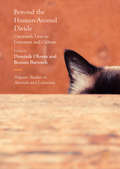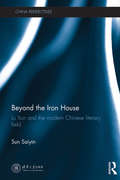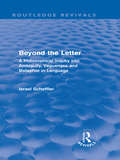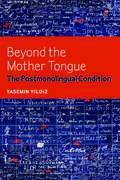- Table View
- List View
Beyond sentidiño: New Diasporic Reflections on Galician Culture (Routledge Studies in Latin American and Iberian Literature)
by Amarelo, Edited by DanielBeyond Sentidiño: New Diasporic Reflections on Galician Culture is an interdisciplinary study of Galician literature, languages, and cultures. The volume brings together essays from fields across the humanities and social sciences to foster a discussion that incorporates new concepts that, as of now, are not part of the imaginary of Galiza: gentrification, language imperialism, youth unemployment, deruralization and deindustrialization, media control, technocapitalism, and gender and sexual normativity. It also serves to moderate a conversation about how independence from the political, material, and sociocultural networks of autonomic Galiza allows diasporic scholars to think of Galician culture in a de-essentializing manner. Working and living in the diaspora provides a lens through which to unmask the hegemonic neocolonial and neoliberal representation and reproduction of Galicianness promoted by different social, political, and mediatic powers.
Beyond the Black Atlantic: Relocating Modernization and Technology
by Walter Goebel Saskia SchabioDebates about the ‘Black Atlantic’ have alerted us to an experience of modernization that diverges from the dominant Western narratives of globalization and technological progress. This outstanding volume expands the concept of the Black Atlantic by reaching beyond the usual African-American focus of the field, presenting fresh perspectives on postcolonial experiences of technology and modernization. A team of renowned contributors come together in this volume in order to: redefine and expand ideas of Black Atlantic challenge unified concepts of modernization from a postcolonial perspective question fashionable concepts of the transnational by returning to the local and the national offer new approaches to cross-cultural mechanisms of exchange explore utopian uses of technology in the postcolonial sphere. Exploring a variety of national, diasporan and transnational counternarratives to Western modernization, Beyond the Black Atlantic makes a valuable contribution to the fields of postcolonial, literary and cultural studies.
Beyond the Black Lady: Sexuality and the New African American Middle Class (New Black Studies Series)
by Lisa B. ThompsonIn this book, Lisa B. Thompson explores the representation of black middle-class female sexuality by African American women authors in narrative literature, drama, film, and popular culture, showing how these depictions reclaim black female agency and illustrate the difficulties black women confront in asserting sexual agency in the public sphere. Thompson broadens the discourse around black female sexuality by offering an alternate reading of the overly determined racial and sexual script that casts the middle class "black lady" as the bastion of African American propriety. Drawing on the work of black feminist theorists, she examines symptomatic autobiographies, novels, plays, and key episodes in contemporary American popular culture, including works by Anita Hill, Judith Alexa Jackson, P. J. Gibson, Julie Dash, Kasi Lemmons, Jill Nelson, Lorene Cary, and Andrea Lee.
Beyond the Blockbusters: Themes and Trends in Contemporary Young Adult Fiction (Children's Literature Association Series)
by Rebekah Fitzsimmons and Casey Alane WilsonContributions by Megan Brown, Jill Coste, Sara K. Day, Rachel Dean-Ruzicka, Rebekah Fitzsimmons, Amber Gray, Roxanne Harde, Tom Jesse, Heidi Jones, Kaylee Jangula Mootz, Leah Phillips, Rachel L. Rickard Rebellino, S. R. Toliver, Jason Vanfosson, Sarah E. Whitney, and Casey Alane WilsonWhile critical and popular attention afforded to twenty-first-century young adult literature has exponentially increased in recent years, classroom materials and scholarship have remained static in focus and slight in scope. Twilight, The Hunger Games, The Fault in Our Stars, and The Hate U Give overwhelm conversations among scholars and critics—but these are far from the only texts in need of analysis.Beyond the Blockbusters: Themes and Trends in Contemporary Young Adult Fiction offers a necessary remedy to this limiting perspective, bringing together essays about the many subgenres, themes, and character types that have until now been overlooked. The collection tackles a diverse range of topics—modern updates to the marriage plot; fairy tale retellings in dystopian settings; stories of extrajudicial police killings and racial justice. The approaches are united, though, by a commitment to exploring the large-scale generic and theoretical structures at work in each set of texts. As a collection, Beyond the Blockbusters is an exciting entryway into a field that continues to grow and change even as its works captivate massive audiences. It will prove a crucial addition to the library of any scholar or instructor of young adult literature.
Beyond the Cloister: Catholic Englishwomen and Early Modern Literary Culture
by Jenna LayRepresentations of Catholic women appear with surprising frequency in the literature of post-Reformation England. Playwrights and poets from William Shakespeare to Andrew Marvell invoke the figure of the nun to powerful and often perplexing effect, and works that never directly address female Catholicism, such as Christopher Marlowe's Hero and Leander, share a discourse with contemporary debates regarding the status of recusant women. Catholic Englishwomen, whether living in convents on the European continent or as recusants in their own country, contributed to these debates, but even as their writings addressed the central religious and political issues of their time, their contributions were effaced and now are largely forgotten. Exploring the writings of Catholic women in conversation with those of Shakespeare, Marvell, Marlowe, Donne, and other canonical authors, Beyond the Cloister shows that nuns and recusants were centrally important to the development of English literature.The defining narratives of early modern England cast nuns as the relics of an unenlightened past and equated Catholic femininity with the dangerous charms of the Whore of Babylon. With careful attention to literary figurations of Catholic femininity and to the vibrant manuscript culture in the English convents, Jenna Lay reveals a far more complex reality. Through their use of tropes, figures, generic patterns, and literary allusions, Catholic women produced politically incendiary and rhetorically powerful lyrics, prayers, polemics, and hagiographies. Drawing on the insights of religious studies, historical formalism, and feminist criticism, Beyond the Cloister offers a reassessment of crucial decades in the development of English literary history.
Beyond the Color Line and the Iron Curtain: Reading Encounters Between Black and Red, 1922-1963
by Kate A. BaldwinExamining the significant influence of the Soviet Union on the work of four major African American authors--and on twentieth-century American debates about race--Beyond the Color Line and the Iron Curtain remaps black modernism, revealing the importance of the Soviet experience in the formation of a black transnationalism. Langston Hughes, W. E. B. Du Bois, Claude McKay, and Paul Robeson each lived or traveled extensively in the Soviet Union between the 1920s and the 1960s, and each reflected on Communism and Soviet life in works that have been largely unavailable, overlooked, or understudied. Kate A. Baldwin takes up these writings, as well as considerable material from Soviet sources--including articles in Pravda and Ogonek, political cartoons, Russian translations of unpublished manuscripts now lost, and mistranslations of major texts--to consider how these writers influenced and were influenced by both Soviet and American culture. Her work demonstrates how the construction of a new Soviet citizen attracted African Americans to the Soviet Union, where they could explore a national identity putatively free of class, gender, and racial biases. While Hughes and McKay later renounced their affiliations with the Soviet Union, Baldwin shows how, in different ways, both Hughes and McKay, as well as Du Bois and Robeson, used their encounters with the U. S. S. R. and Soviet models to rethink the exclusionary practices of citizenship and national belonging in the United States, and to move toward an internationalism that was a dynamic mix of antiracism, anticolonialism, social democracy, and international socialism. Recovering what Baldwin terms the "Soviet archive of Black America," this book forces a rereading of some of the most important African American writers and of the transnational circuits of black modernism.
Beyond the Courtroom
by Fali S. NarimanDiscover the profound contributions of Fali S. Nariman, a towering figure in Indian jurisprudence, through this authoritative anthology that encapsulates his lifelong dedication to law and justice. Beyond the Courtroom presents a meticulously curated selection of his most influential speeches, groundbreaking articles, and illuminating lectures, showcasing the vast breadth and depth of his legal and constitutional expertise.This collection spans the entirety of Nariman&’s distinguished career, offering incisive analyses of national issues, legal reforms, and critical reflections on arbitration, judiciary, and constitutional law. Each section highlights a unique facet of Nariman&’s intellectual rigour and legal acumen, providing readers with a comprehensive understanding of his perspectives on justice, governance, and the rule of law.With contributions that have shaped legal discourse and inspired countless professionals, this volume is an essential resource for legal scholars, practitioners, and anyone interested in the foundational principles of law, justice, and constitutional governance. Beyond the Courtroom stands as a testament to the enduring legacy of one of India&’s most esteemed legal minds.
Beyond the Cultural Turn: New Directions in the Study of Society and Culture (Studies on the History of Society and Culture #34)
by Margaret C. Jacob Richard Biernacki Jerrold Seigel Karen Halttunen Sonya O. Rose Hayden White William H. Sewell Margaret R. Somers Caroline Bynum Steven FeiermanNothing has generated more controversy in the social sciences than the turn toward culture, variously known as the linguistic turn, culturalism, or postmodernism. This book examines the impact of the cultural turn on two prominent social science disciplines, history and sociology, and proposes new directions in the theory and practice of historical research.The editors provide an introduction analyzing the origins and implications of the cultural turn and its postmodernist critiques of knowledge. Essays by leading historians and historical sociologists reflect on the uses of cultural theories and show both their promise and their limitations. The afterword by Hayden White provides an assessment of the trend toward culturalism by one its most influential proponents.Beyond the Cultural Turn offers fresh theoretical readings of the most persistent issues created by the cultural turn and provocative empirical studies focusing on diverse social practices, the uses of narrative, and the body and self as critical junctures where culture and society intersect.
Beyond the Culture Tours: Studies in Teaching and Learning With Culturally Diverse Texts
by Sarah Jordan Gladys Cruz Jos‚ Mel‚ndez Steven OstrowskiIn calling this book Beyond the Culture Tours, the authors bring the reader's attention to a set of issues in the teaching of literature and culture. The Culture Tour is an old concept in the West, dating back to the seventeenth century. The educated young man -- it was an exclusively male project at first -- was expected to round off his education with the Grand Tour. This meant a visit to the major sites on the European continent, particularly Greece and Rome, and occasionally to the Holy Land. The object was to have a first-hand view of these monuments, and looking at them alone brought people the name of being cultured or well-traveled. As the idea spread in the early part of the twentieth century, it allowed for the vicarious tour rather than the actual one. Students were asked to look at collections of art or reproductions of art work, listen to concerts or later recordings, and to read certain classical works drawn from what has come to be known as "the canon." The point of this form of education was that exposure to these works in itself formed a version of the Grand Tour. The basic idea behind the tour approach is that exposure to a culture in books is like travel to an ethnic theme park. This volume looks beyond the tour approach and reports on the results of a four-year project undertaken by a research team from the National Center for Research in the Learning and Teaching of Literature. Their intent was to study the teaching and impact of multicultural literature. The team examined how students approached texts that either came from their culture or from another, and how teachers perceived the students, the literature, and their role. This volume details various aspects of their findings.
Beyond the Doctrine of Man: Decolonial Visions of the Human
by Joseph Drexler-Dreis and Kristien JustaertCatalyzed by Sylvia Wynter’s questioning of modern/colonial descriptions of the human person, the essays in Beyond the Doctrine of Man interrogate the problem of these definitions of the human person and take up the struggle to decolonize and unsettle such descriptions.Contributors: Rufus Burnett Jr., M. Shawn Copeland, Yomaira C. Figueroa, Patrice Haynes, Xhercis Méndez, Andrew Prevot, Mayra Rivera, Linn Marie Tonstad, Alexander G. Weheliye
Beyond the Echo Chamber: Reshaping Politics Through Networked Progressive Media
by Jessica Clark Tracy Van SlykeStrategies and success stories: &“A must read for media practitioners, consumers, and progressives of all stripes.&” —Chris Hayes In the twenty-first century, a new breed of networked progressive media—from Brave New Films to Talking Points Memo to Feministing and beyond—have informed and engaged millions, influencing political campaigns, public debates, and policymaking at unprecedented levels. In Beyond the Echo Chamber, media experts Jessica Clark and Tracy Van Slyke tell the story of the rise of progressive media and lay out a clear, hard-hitting theory of ongoing impact. A vital strategic guide based on years of research and extensive interviews with key media players and new media experts, Beyond the Echo Chamber will change the national conversation about progressive media and the future of journalism itself. For progressive journalists, bloggers, producers, activists, citizens, and policymakers committed to change, here is a roadmap to victory.
Beyond the Family Romance: The Legend of Pascoli (The Royal Society of Canada Special Publications)
by Maria TruglioGiovanni Pascoli (1855–1912) is one of Italy’s most canonical and beloved poets. In Beyond the Family Romance, Maria Truglio offers fresh insight into the uncanny qualities of Pascoli’s domestic verse. As suggested by the Freudian title, this study opens a dialogue between Pascoli’s literature and Freud’s theories, with a particular focus on each author’s interrogation of origins. Through close readings and historical contextualization, themes of regression, memory, and other manifestations of ‘origins’ are analyzed, moving Pascoli’s poetry beyond the biographical strictures that have hitherto confined it.Truglio’s post-structuralist readings question the dichotomy between ‘safety within the home’ and the ‘threatening outside world,’ revealing the ambivalences with which images of the home are fraught in Pascoli’s poetry. In addition to the sustained comparison with Freud’s writing, Beyond the Family Romance explores parallels between Pascoli’s work and such writers as Tarchetti, Boito, Poe, and Invernizio. Rethinking the concept of the fanciullino (‘little child’), Truglio shows that Pascoli’s poetry enacts a symbiosis between the logic of the rational modern adult and the mythic vision of the child.
Beyond the Fascist Century: Essays in Honour of Roger Griffin
by Aristotle Kallis Constantin IordachiThis book evaluates the current and future state of fascism studies, reflecting on the first hundred years of fascism and looking ahead to a new era in which fascism studies increasingly faces fresh questions concerning its relevance and the potential reappearance of fascism. This wide-ranging work celebrates Roger Griffin’s contributions to fascism studies – in conceptual and definitional terms, but also in advancing our understanding of fascism – which have informed related research in a number of fields and directions since the 1990s. Bringing together three ‘generations’ of fascism scholars, the book offers a combination of broad conceptual essays and contributions focusing on particular themes and facets of fascism. The book features chapters, which, although diverse in their approaches, explore Griffin’s work while also engaging critically with other schools of thought. As such, it identifies new avenues of research in fascism studies, placing Griffin’s work within the context of new and emerging voices in the field.
Beyond the First Draft: The Art of Fiction
by John CaseyFor students and writers alike, a brilliant guide to the craft of writing by the National Book Award-winning author of Spartina. National Book Award winner John Casey is a masterful novelist who is also an inspiring and beloved teacher. In Beyond the First Draft he offers essential and original insights into the art of writing--and rewriting--fiction. Through anecdotes about other writers' methods and habits (as well as his own) and close readings of literature from Aristotle to Zola, the essays in this collection offer "suggestions about things to do, things to think about when your writing has got you lost in the woods." In "Dogma and Anti-dogma" Casey sets out the tried-and-true advice and then comments on when to apply it and when to ignore it. In "What's Funny" he considers the range of comedy from pratfalls to elegant wit. In "In Other Words" he discusses translations and the surprising effects that translating can have on one's native language. In "Mentors" he pays tribute to those who have guided him and other writers. Throughout the fourteen essays there are notes on voice, point of view, structure, and other crucial elements. This book is an invaluable resource for aspiring writers and a revitalizing companion for seasoned ones.
Beyond the Fruited Plain: Food and Agriculture in U.S. Literature, 1850-1905
by Kathryn Cornell DolanAgriculture in the United States has changed dramatically in the last two hundred years. Economic transformation marked by the expansion of the industrial economy and big business has contributed to an increase in industrial food production. Amid this change, policymakers and cultural critics have debated the best way to produce food and wealth for an expanding population with imperialistic tendencies. In a sweeping overview, Beyond the Fruited Plain traces the connections between nineteenth-century literature, agriculture, and U.S. territorial and economic expansion. Bringing together theories of globalization and ecocriticism, Kathryn Cornell Dolan offers new readings on the texts of such literary figures as Herman Melville, Frank Norris, Mark Twain, Henry David Thoreau, and Harriet Beecher Stowe as they examine conflicts of food, labor, class, race, gender, and time—issues still influencing U.S. food politics today. Beyond the Fruited Plain shows how these authors use their literature to imagine agricultural alternatives to national practices and in so doing prefigure twenty-first-century concerns about globalization, resource depletion, food security, and the relation of industrial agriculture to pollution, disease, and climate change.
Beyond the Gibson Girl: Reimagining the American New Woman, 1895-1915
by Martha H. PattersonChallenging monolithic images of the New Woman as white, well-educated, and politically progressive, this study focuses on important regional, ethnic, and sociopolitical differences in the use of the New Woman trope at the turn of the twentieth century. Using Charles Dana Gibson's "Gibson Girls" as a point of departure, Martha H. Patterson explores how writers such as Pauline Hopkins, Margaret Murray Washington, Sui Sin Far, Mary Johnston, Edith Wharton, Ellen Glasgow, and Willa Cather challenged and redeployed the New Woman image in light of other "new" conceptions: the "New Negro Woman," the "New Ethics," the "New South," and the "New China." As she appears in these writers' works, the New Woman both promises and threatens to effect sociopolitical change as a consumer, an instigator of evolutionary and economic development, and, for writers of color, an icon of successful assimilation into dominant Anglo-American culture. Examining a diverse array of cultural products, Patterson shows how the seemingly celebratory term of the New Woman becomes a trope not only of progressive reform, consumer power, transgressive femininity, modern energy, and modern cure, but also of racial and ethnic taxonomies, social Darwinist struggle, imperialist ambition, assimilationist pressures, and modern decay.
Beyond the Godfather: Italian American Writers on the Real Italian American Experience
by Jay Parini A. Kenneth CiongoliIntriguing personal essays by Italian American writers.
Beyond the Grammar Wars: A Resource for Teachers and Students on Developing Language Knowledge in the English/Literacy Classroom
by Terry LockeAre there evidence-based answers to the broad question "What explicit knowledge about language in teachers and/or students appears to enhance literacy development in some way"? Distinguished by its global perspective, its currency, and its comprehensiveness, Beyond the Grammar Wars: provides an historical overview of the debates around grammar and English/literacy teaching in four settings: the US, England, Scotland and Australia offers an up-to-date account of what the research is telling (and not telling) us about the effectiveness of certain kinds of grammar-based pedagogies in English/literacy classrooms takes readers into English/literacy classrooms through a range of examples of language/grammar-based pedagogies which have proven to be successful addresses metalinguistic issues related to changes in textual practices in a digital and multimodal age, and explores the challenges for educators who are committed to finding a "usable grammar" to contribute to teaching and learning in relation to these practices. All of the contributors are acknowledged experts in their field. Activities designed for use in language and literacy education courses actively engage students in reflecting on and applying the content in their own teaching contexts.
Beyond the Great Forgetting: Narrative Resistance in American Literature on Early-Onset Alzheimer’s Disease
by Patrick GruenerDrawing on a selection of carefully curated autobiographical and fictional portrayals of the dementia experience, this book gives voice to some of the most pressing ethical issues that commonly arise in the context of a dementing disorder, and calls attention to various forms of narrative resistance in contemporary American literature on early-onset Alzheimer’s disease (AD). Based on the premise that the current public discourse on AD is largely dominated by an anxiety and fear-promoting conception of the illness, this multilayered inquiry strives to look beyond the widespread horrors of forgetting and loss in AD, and, in doing so, attempts to give a better, more accurate, and more balanced impression of what it means to be living with such a diagnosis.
Beyond the Human Voice: Dystopische Soundscapes in den Künsten (Cultural Animal Studies #23)
by Susanne Rode-Breymann Martin UllrichSeuchen, ökologische Krisen, autoritäre Staaten, fehlgesteuerte künstliche Intelligenz – die Künste haben diese Themen in dystopischen Weltentwürfen aufgegriffen. Der Frage, wie es in diesen dystopischen Welten klingt, ist der vorliegende Band gewidmet – auch nach dem Verlust von Musik in der Corona-Pandemie. Leitmotiv ist das Verstummen der vox humana und die an ihre Stelle tretende Tierstimme. Der Klang der Dystopie verbindet sich so mit dem Bedeutungszuwachs, den nichtmenschliche Stimmen in post-anthropozentrischen Forschungsansätzen wie den Human-Animal Studies inzwischen erfahren haben, die hier in Dialog mit Kunstwissenschaften treten.
Beyond the Human-Animal Divide: Creaturely Lives in Literature and Culture (Palgrave Studies in Animals and Literature)
by Dominik Ohrem Roman BartoschThis volume explores the potential of the concept of the creaturely for thinking and writing beyond the idea of a clear-cut human-animal divide, presenting innovative perspectives and narratives for an age which increasingly confronts us with the profound ecological, ethical and political challenges of a multispecies world. The text explores written work such as Samuel Beckett's Worstward Ho and Michel Foucault's The Order of Things, video media such as the film "Creature Comforts" and the video game Into the Dead, and photography. With chapters written by an international group of philosophers, literary and cultural studies scholars, historians and others, the volume brings together established experts and forward-thinking early career scholars to provide an interdisciplinary engagement with ways of thinking and writing the creaturely to establish a postanthropocentric sense of human-animal relationality.
Beyond the Iron House: Lu Xun and the Modern Chinese Literary Field (China Perspectives)
by Saiyin SunBeyond the Iron House is a critical study of a crucial period of life and work of the modern Chinese writer Lu Xun. Through thorough research into historical materials and archives, the author demonstrates that Lu Xun was recognized in the literary field much later than has hitherto been argued. Neither the appearance of "Kuangren riji" (Diary of a madman) in 1918 nor the publication of Nahan (Outcry) in 1923 had catapulted the author into nationwide prominence; in comparison with his contemporaries, neither was his literary work as original and unique as many have claimed, nor were his thoughts and ideas as popular and influential as many have believed; like many other agents in the literary field, Lu Xun was actively involved in power struggles over what was at stake in the field; Lu Xun was later built into an iconic figure and the blind worship of him hindered a better and more authentic understanding of many other modern writers and intellectuals such as Gao Changhong and Zhou Zuoren, whose complex relationships with Lu Xun are fully explored and analysed in the book.
Beyond the Language Classroom
by Phil Benson Hayo ReindersThis comprehensive exploration of theoretical and practical aspects of out-of-class teaching and learning from a variety of perspectives and in various settings around the world includes a theoretical overview of the field, 11 data-based case studies and practical advice on materials development for independent learning.
Beyond the Letter: A Philosophical Inquiry into Ambiguity, Vagueness and Methaphor in Language (Routledge Revivals)
by Israel SchefflerAmbiguity, vagueness and metaphor are pervasive features of language, deserving of systematic study in their own right. Yet they have frequently been considered mere deviations from ideal language or obstacles to be avoided in the construction of scientific systems. First published in 1979, Beyond the Letter offers a consecutive study of these features from a philosphical point of view, providing analyses of each and treating their relations to one another. Addressed to the fundamental task of logical and semantic explanation, the book employs an inscriptional methodology in the attempt to avoid prevalent forms of question-begging, and, further, in the conviction that sparseness of assumption often reveals points of theoretical interest irrespective of methodolgical preference. The author distinguishes and analyses several varieties of ambiguity, developing new semantic notions in the process; recasts the philosophical treatment of vagueness in the light of recent criticisms of analyticity; discusses the bearing of vagueness on logic; and provides a systematic critique of major recent interpretations of metaphor, developing a revised version of contextualism.
Beyond the Mother Tongue: The Postmonolingual Condition
by Yasemin YildizBeyond the Mother Tongue examines distinct forms of multilingualism, such as writing in one socially unsanctioned “mother tongue” about another language (Franz Kafka); mobilizing words of foreign derivation as part of a multilingual constellation within one language (Theodor W. Adorno); producing an oeuvre in two separate languages simultaneously (Yoko Tawada); and mixing different languages, codes, and registers within one text (Feridun Zaimoglu).
